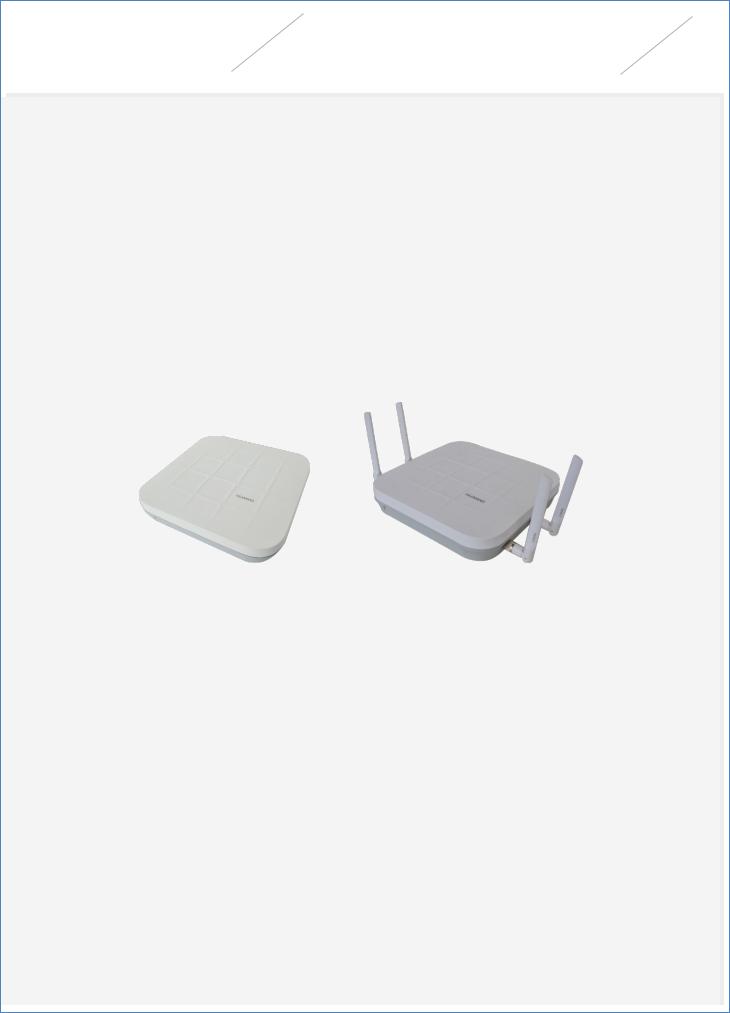Huawei AP6050DN, AP6150DN Service Manual

Huawei
AP6050DN&AP6150DN
Access Points
Datasheet

Huawei AP6050DN&AP6150DN |
|
01 |
Access Points |
Datasheet |
|
|
.............................................................................................................................Product Overview |
// |
Huawei AP6050DN&AP6150DN are the latest-generation technology-leading wireless access points (AP). In compliance with the 802.11ac Wave 2 standards, They provide secure gigabit wireless access and supports concurrent data processing for more users. The APs support 4 x 4 MIMO and four spatial streams and provides a rate of up to 2.53 Gbit/s. The APs support smooth evolution from 802.11n standards to 802.11ac standards, and meet the bandwidth requirements of large-bandwidth services such as High Definition (HD) video streams, multimedia, and desktop cloud services, delivering smooth and high-quality wireless services to enterprise users. With industry-leading capabilities in terms of signal coverage, access density, and operation stability, the APs provides high-quality mobile cloud access services to help customers build the optimal wireless network. The AP6050DN&AP6150DN deliver industry-leading performance in a rugged, attractive enclosure and are ideal for medium and large high-density scenarios, such as mobile office, elementary education, and higher education.
AP6050DN |
AP6150DN |
ˉ802.11ac Wave 2 standards compliance, MU-MIMO, delivering services simultaneously on 2.4G and 5G radios; at a rate of up to 800 Mbit/s at 2.4 GHz, 1.73 Gbit/s at 5 GHz, and 2.53 Gbit/s for the device.
ˉDual Ethernet interfaces support link aggregation and traffic load balancing to ensure link reliability.
ˉUSB interface used for external power supply and storage.
ˉSupports the Fat, Fit, and cloud modes and enables Huawei cloud-based management platform to manage and operate APs and services on the APs, reducing network O&M costs.
Feature Descriptions........................................................................................................................ |
// |
MU-MIMO
The AP supports MU-MIMO. MU-MIMO technology allows an AP to send data to multiple STAs at the same time (currently, most 802.11n/11ac Wave 1 APs can only send data to one STA simultaneously). The technology marks the start of the 802.11ac Wave 2 era.
GE access
The AP supports the 80-MHz bandwidth mode. Frequency bandwidth increase brings extended channels and more sub-carriers for data transmission, and a 2.16 times higher rate. Support for High Quadrature Amplitude Modulation (HQAM) at 256-QAM and 4 x 4 MIMO increases the 5 GHz radio rate to 1.73 Gbit/s. The throughput of the AP is four times that of traditional 802.11n APs under the similar conditions.

Huawei AP6050DN&AP6150DN |
|
02 |
Access Points |
Datasheet |
Cloud-based management
Huawei Cloud Managed Network (CMN) Solution consists of the cloud management platform and a full range of cloud managed network devices. The cloud management platform provides various functions including management of APs, tenants, applications, and licenses, network planning and optimization, device monitoring, network service configuration, and value-added services.
High Density Boost technology
Huawei uses the following technologies to address challenges in high-density scenarios, including access problems, data congestion, and poor roaming experience:
•SmartRadio for air interface optimization
ˉLoad balancing during smart roaming: The load balancing algorithm can work during smart roaming for load balancing detection among APs on the network after STA roaming to adjust the STA load on each AP, improving network stability.
ˉIntelligent DFA technology: The dynamic frequency assignment (DFA) algorithm is used to automatically detect adjacent-channel and co-channel interference, and identify any 2.4 GHz redundant radio. Through automatic inter-AP negotiation, the redundant radio is automatically switched to another mode (dual-5G AP models support 2.4G-to-5G switchover) or is disabled to reduce 2.4 GHz co-channel interference and increase the system capacity.
ˉIntelligent conflict optimization technology: The dynamic enhanced distributed channel access (EDCA) and airtime scheduling algorithms are used to schedule the channel occupation time and service priority of each user. This ensures that each user is assigned relatively equal time for using channel resources and user services are scheduled in an orderly manner, improving service processing efficiency and user experience.
•Air interface performance optimization
ˉIn high-density scenarios where many users access the network, increased number of low-rate STAs consumes more resources on the air interface, reduces the AP capacity, and lowers user experience. Therefore, Huawei APs will check the signal strength of STAs during access and rejects access from weak-signal STAs. At the same time, the APs monitor the rate of online STAs in real time and forcibly disconnect low-rate STAs so that the STAs can reassociate with APs that have stronger signals. The terminal access control technology can increase air interface use efficiency and allow access from more users.
•5G-prior access (Band steering)
ˉThe APs support both 2.4G and 5G frequency bands. The 5G-prior access function enables an AP to steer STAs to the 5 GHz frequency band first, which reduces load and interference on the 2.4 GHz frequency band, improving the user experience.

Huawei AP6050DN&AP6150DN |
|
03 |
Access Points |
Datasheet |
Wired and wireless dual security guarantee
To ensure data security, Huawei APs integrate wired and wireless security measures and provide comprehensive security protection.
•Authentication and encryption for wireless access
ˉThe APs support WEP, WPA/WPA2–PSK, WPA/WPA2–PPSK, WPA/WPA2–802.1X, and WAPI authentication/encryption modes to ensure security of the wireless network. The authentication mechanism is used to authenticate user identities so that only authorized users can access network resources. The encryption mechanism is used to encrypt data transmitted over wireless links to ensure that the data can only be received and parsed by expected users.
•Analysis on non-Wi-Fi interference sources
ˉHuawei APs can analyze the spectrum of non-Wi-Fi interference sources and identify them, including baby monitors, Bluetooth devices, digital cordless phones (at 2.4 GHz frequency band only), wireless audio transmitters (at both the 2.4 GHz and 5 GHz frequency bands), wireless game controllers, and microwave ovens. Coupled with Huawei eSight, the precise locations of the interference sources can be detected, and the spectrum of them displayed, enabling the administrator to remove the interference in a timely manner.
•Rogue device monitoring
ˉHuawei APs support WIDS/WIPS, and can monitor, identify, defend, counter, and perform refined management on the rogue devices, to provide security guarantees for air interface environment and wireless data transmission.
•AP access authentication and encryption
ˉThe AP access control ensures validity of APs. The CAPWAP link protection and DTLS encryption provide security assurance, improving data transmission security between the AP and the AC.
Automatic radio calibration
Automatic radio calibration allows an AP to collect signal strength and channel parameters of surrounding APs and generate AP topology according to the collected data. Based on interference from authorized APs, rogue APs, and non-Wi-Fi interference sources, each AP automatically adjusts its transmit power and working channel to make the network operate at the optimal performance. In this way, network reliability and user experience are improved.
Automatic application identification
Huawei APs support smart application control technology and can implement visualized control on Layer 4 to Layer 7 applications.
•Traffic identification
ˉCoupled with Huawei ACs, the APs can identify over 1600 common applications in various office scenarios. Based on the identification results, policy control can be implemented on user services, including priority adjustment, scheduling, blocking, and rate limiting to ensure efficient bandwidth resource use and improve quality of key services.
•Traffic statistics collection
ˉTraffic statistics of each application can be collected globally, by SSID, or by user, enabling the network administrator to know application use status on the network. The network administrator or operator can implement visualized control on service applications on smart terminals to enhance security and ensure effective bandwidth control.

Huawei AP6050DN&AP6150DN |
|
04 |
Access Points |
Datasheet |
Basic Specifications......................................................................................................................... //
|
|
|
Hardware specifications |
|||||
|
|
|
|
|
|
|
|
|
|
|
Item |
|
|
|
|
|
Description |
|
|
|
|
|
|
|
|
|
|
|
Dimensions (H x W x D) |
|
|
56 mm x 220 mm x 220 mm |
|||
|
|
|
|
|
|
|
|
|
|
|
Weight |
|
|
1.30 kg |
|||
|
Technical |
|
|
|
|
|
|
|
|
|
|
|
2 x 10/100/1000M self-adaptive Ethernet interface (RJ45) |
||||
|
specifications |
|
|
|
||||
|
Interface type |
|
|
1 x Management console port (RJ45) |
||||
|
|
|
|
|||||
|
|
|
|
|
1 x USB interface |
|||
|
|
LED indicator |
|
|
Indicates the power-on, startup, running, alarm, and fault status of the system. |
|||
|
|
|
|
|
|
|
|
|
|
|
Power input |
|
|
12 V DC ± 10% |
|||
|
|
|
|
PoE power supply: in compliance with IEEE 802.3at |
||||
|
Power |
|
|
|
||||
|
|
|
|
22.9 W (excluding the output power of the USB port) |
||||
|
specifications |
Maximum power |
|
|
||||
|
|
|
|
|
|
NOTE |
||
|
|
|
|
|
|
|||
|
|
|
|
|
|
|
||
|
|
consumption |
|
|
|
|
|
|
|
|
|
|
The actual maximum power consumption depends on local laws and regulations. |
||||
|
|
|
|
|
||||
|
|
Operating temperature |
|
|
–10°C to +50°C |
|||
|
|
|
|
|
|
|
|
|
|
|
Storage temperature |
|
|
–40°C to +70°C |
|||
|
|
|
|
|
|
|
|
|
|
|
|
|
|
|
|
|
|
|
Environmental |
Operating humidity |
|
|
5% to 95% (non-condensing) |
|||
|
|
|
|
|
|
|
|
|
|
specifications |
Dustproof and |
|
|
IP41 |
|||
|
|
waterproof grade |
|
|
||||
|
|
|
|
|
|
|
|
|
|
|
Altitude |
|
|
–60 m to +5000 m |
|||
|
|
|
|
|
|
|
|
|
|
|
Atmospheric pressure |
|
|
53 kPa to 106 kPa |
|||
|
|
|
|
|
|
|
|
|
|
|
Antenna type |
|
|
AP6050DN: built-in dual-band antennas |
|||
|
|
|
|
AP6150DN: external dual-band antennas |
||||
|
|
|
|
|
||||
|
|
|
|
|
AP6050DN: |
|||
|
|
|
|
|
2.4 GHz:4dBi |
|||
|
|
Antenna gain |
|
|
5 GHz: 4dBi |
|||
|
|
|
|
AP6150DN: |
||||
|
|
|
|
|
||||
|
Radio |
|
|
|
2.4GHz: 3.5dBi |
|||
|
specifications |
|
|
|
5GHz: 4dBi |
|||
|
|
|
|
|
||||
|
|
Maximum number of |
|
|
≤ 16 |
|||
|
|
SSIDs for each radio |
|
|
|
|
|
|
|
|
Maximum number of |
|
|
≤ 512 |
|||
|
|
|
|
|
|
|
NOTE |
|
|
|
|
|
|
|
|
||
|
|
users |
|
|
|
|
|
|
|
|
|
|
|
|
|
|
|
|
|
|
|
|
The actual number of users varies according to the environment. |
|||
